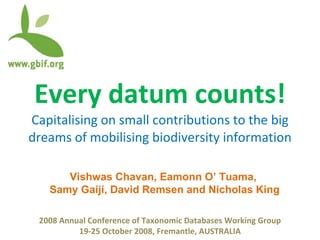Chavan 02 02 Gbif Small To Big
- 1. Every datum counts! Capitalising on small contributions to the big dreams of mobilising biodiversity information Vishwas Chavan, Eamonn OŌĆÖ Tuama, Samy Gaiji, David Remsen and Nicholas King 2008 Annual Conference of Taxonomic Databases Working Group 19-25 October 2008, Fremantle, AUSTRALIA
- 2. Both biodiversity and biodiversity data are unevenly distributed around the world: Digital Divide Content Divide Lingual Divide Knowledge Divide Emerging catastropheŌĆ”ŌĆ”ŌĆ”ŌĆ” Developing World Biodiversity Biodiversity Data Developed World
- 3. Uneven distribution of biodiversity
- 4. Large volume of biodiversity data and information is in languages other than English
- 5. Biodiversity Informatics activities are concentrated in the North
- 6. Few more reasonsŌĆ”. Investment in biodiversity information management is towards large projects Research in biodiversity informatics is focused towards large data publishers Small Data Publishers ŌĆō A neglected mass!
- 7. Biodiversity Knowledge Divide: Emerging Catastrophe
- 8. Open Access movement can help mobilise data - (a) from mega-biodiversity regions, and (b) by small data publishers Good News!
- 9. Small Data Publishers: Who are they? (1) CanŌĆÖt discover, access, and use their data Do not know how to manage data for reuse by others Lack of skills, infrastructure, and support for ŌĆśinteroperableŌĆÖ data management More interested in peer-reviewed publishing than data publishing ŌĆō as former brings recognition and funding
- 10. Small Data Publishers: Who are they? (2) PIŌĆÖs of small scale projects, small and medium sized R&D organisations and NGOs, Citizen Scientists Citizen Scientists- e.g. Peoples Biodiversity Register P. Bryan HeidornŌĆÖs Hypothesis: ŌĆ£Disproportionate amount of dark data is in the tail of scienceŌĆØ Small Data Publishers forms the ŌĆ£Long tailŌĆØ as well ŌĆ£dropletsŌĆØ of ŌĆśOceans of Biodiversity DataŌĆÖ
- 11. Small Are BIG! Long tail or Dark Data is economically and ecologically very critical Most of existing and future data would be hold by Small Data Publishers 80% of current investment is towards Small Data Publishers Total Awards: 9347 Big Awards: 1869 SMALL Awards: 7478 Source: Curating the Dark Data in the Long tail of science by P. Bryan Heidorn
- 12. Characteristics of SDP Data Heterogeneous Distributed and isolated Manually generated Individual creation Not maintained for reuse by others Obscured or protected Uneven distribution as well unequal access It is highly ŌĆ£UnorganisedŌĆØ data sector.......
- 13. Festive uses of bio resources Census of trees Uses of Plants Status and knowledge about medicinal plants Census of Birds Birds signs for forecasting or weather change Wild Animals Burrowing or sub-soil fauna Paudi village, Siwani, India
- 14. Need standards to discover and access such data! Domestic Animals Social belief about biodiversity Citizen Scientists Seed Diversity Millions of RamsinghŌĆÖs across the world are busy in generating biodiversity data
- 15. What do we lack? Data Publishing Framework ŌĆō Lack awareness about current knowledge system Recognition for Data Publishing Data standards for wide spectrum of biodiversity and associated data Suite of standards for data life cycle (generation to dissemination) Standards addressing data generation phase
- 16. What do we lack? Tools for Data Capture at its source Metadata creation as close to the source of data as possible Multilingual tools and standards Hassle-free, skill-level independent tools Because..... Adapting to standards is time-consuming as well costly exercise
- 17. Data mobilisation is like moving mountainsŌĆ”ŌĆ”. Digital Biodiversity Data
- 18. What Can be done! Data Publishing Framework Proposed GBIF recommendation on Discovery and Publishing of Biodiversity Data GUID for data set and data records Expedite the process of standards development Standards development, ratification and uptake Hassle-free, skill-level independent, easy to adapt standards Standards as integral part of recording / monitoring devices Metadata creation as close to source as possible
- 19. What Can be done! Standards for interoperability and/or integration with non-biodiversity data Evaluation of authenticity, reliability, and data quality as close to source as possible Outreach to national/regional/thematic standards building initiatives Domain experts find it difficult to understand / adapt standards Cultural as well lingual barriers Engagement of eastern, southern, mega-biodiversity communities in standards development processes
- 20. What Can be done! Internationalise standards Awareness in mega-biodiversity world about standards Multilingual dissemination ŌĆō talk the languages that people understand the bests Think Globally ŌĆō Act Locally Moving beyond comfort zone Standards for unorganised data sector Standards for citizen scientists Address concerns of data sensitivity through standards implementation Will standards help me in identification and protection of sensitive data?
- 21. ŌĆ£ KrishnaŌĆØ can move data mountains, if standards bodies act as ŌĆ£KamdhenusŌĆØ TDWG GBIF
- 22. becauseŌĆ”ŌĆ” Every datum counts!






















